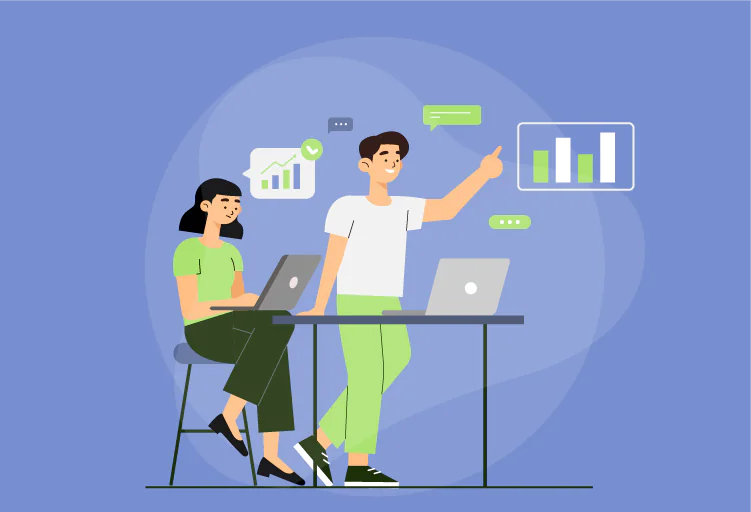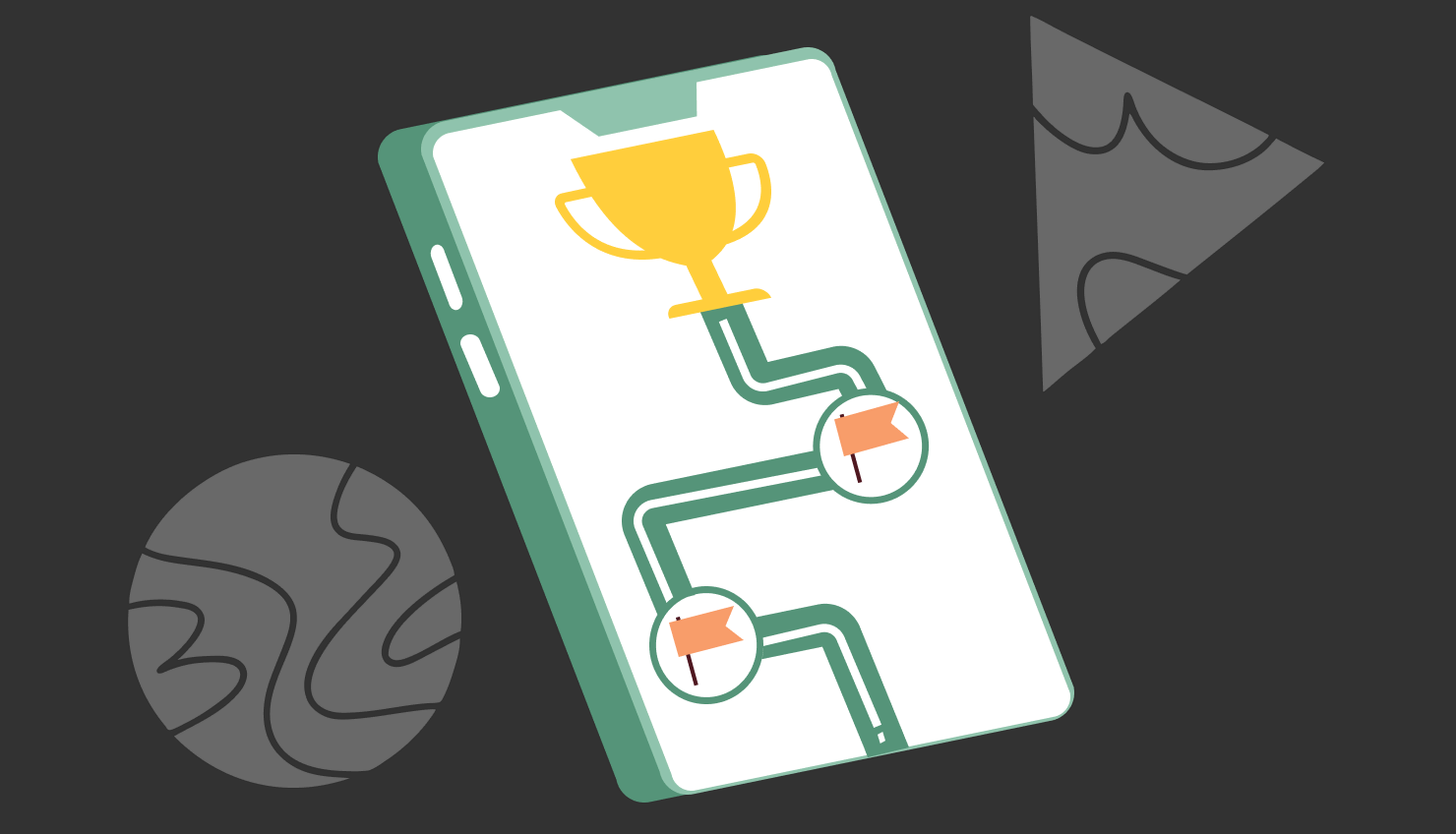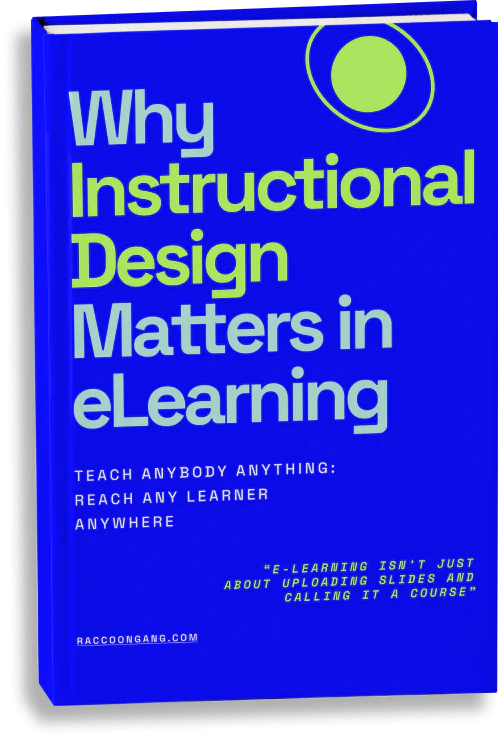Introduction to Gamification in Corporate Training
Gamification in corporate training implies the introduction of game mechanics into corporate e-learning solutions. No, it doesn’t mean that employees will now enjoy mandatory training sessions as much as playing a PlayStation game. However, it does mean that 90% of employees will become more productive at work.
Here are some of the goals of gamification in corporate training:
- Improve learning outcomes
- Foster teamwork
- Develop interest
- Make courses easy to remember
Overall, it may sound strange, but adult learners greatly benefit from gamified environments. Gamification results in 14% higher scores on skill-based knowledge assessments, according to a study by the University of Colorado.
Gamification in corporate training has also been proven to yield better task completion rates and increased chances of practical usage and application of learning at work if executed correctly.

The impact of gamification on employees. © 2025 Zippia, Inc.
Benefits of Gamification in Corporate Training
Continuing the topic, we want to emphasize once again — indeed, gamification makes corporate training more enjoyable. Behind the word “enjoyable” are hidden thoughtful, scientifically based training methods, or in our case, training that makes learning less boring, dry, and passive. Instead, you get training materials that really change how people learn, interact, and perform.
What can be marked as direct benefits of gamification:
- The level of knowledge of employees increases. Learners absorb information faster when they’re actively involved, not just sleepily contemplating slides that go by.
- Motivation that encompasses everyone. Points, progress bars, and badges create the same sense of achievement. Instead of a simple certificate printed by your HR, each employee receives their own rewards. The result? While badges are being acquired, new knowledge is being stored in the brain 😉
- Teamwork is not only at corporate parties. Shared challenges encourage collaboration and build healthy competition across teams.
- Better learning. Interactive training stays in memory long after the session ends. Just like computer games with a great storyline, trainings built on game mechanics stay in the memory of participants.
- Clear progress tracking. Defined objectives and measurable milestones let trainers see who is missing the material.
From experience, we should say that successful gamification, especially in corporate training, doesn’t happen by luck. All of the above benefits will be in your pocket only if you start it correctly. We will talk about how to start gamification in the next blocks of the article — but first, let’s make sure that you really should switch from traditional learning to an interactive one.
Traditional vs. Gamified Corporate Training
Regardless of their age, most learners are motivated by rewards and recognition. While gamification in corporate can be more expensive than traditional training and requires a relatively long lead time, its learning gains also surpass.
Gamified training exceeds traditional approaches because of this:
- Improves learning and engagement
- Develops a sense of accomplishment
- Stimulates necessary behavioral changes
- Summons healthy competition
- Include collaborative mechanics, such as team quests
- Shared goals and peer kudos systems
These elements support a sense of autonomy and perceived usefulness, both proven in workplace studies to increase participation and satisfaction.
So, if you are thinking about whether or not gamified corporate training has learning gains, the answer is an absolute YES! Moreover, the return that you get upon investing in gamification is also much higher. This is chiefly because gamified training influences a better ability for learners to recall, retain, and make practical use of what is learned.
Addressing a Multitude of Training Needs Through Gamified Corporate Training
Another thing that concerns employers and trainers is whether or not gamification in corporate training works for different corporate training needs. The answer is also YES. Today, gamified corporate training is being used in almost all departments and in numerous areas of varying industries.
Common areas that employees today are being trained in through this technique include:
- Compliance
- Workplace etiquettes
- Product knowledge
- Professional skills
- Induction
- Soft skills
- Job simulation
- Quality assurance
- Sales
- Customer handling
- Machine operation
Gamification in corporate training can be further used to:
- Enhance overall learning experience in eLearning settings by incorporating beneficial games or gamified tests.
- Reinforce practices and behaviors through online gamified assessments.
- Field enablement outside the office.
- Safety refreshers.
- Customer-facing skills (support/sales) with branching scenarios.
Things You Should Know to Succeed at Introducing Gamification in Corporate Training
E-learning Gamification is a big hit in the corporate world and training industries. With that said, it is also the next big thing that other industries in the world are going to take on. In fact, a lot of them already have.
Nonetheless, gamified corporate training should not be implemented just due to the fact that it has a tendency to improve learners’ engagement. You should also be focused on other benefits and how you can make the most of your investment and efforts.
But how can you get these benefits? Simply by taking the following points into account before you let the idea take over in full swing, in order to implement it correctly.
1. The Purpose
Gamification in corporate training should not be done with the sole purpose of making learning fun. You need to have a definite purpose, a goal that you want learners to accomplish. Without a clear purpose, the training will fail to make an impression. This implies zero retention and wastage of time, money, and effort.
Having a purpose for training and gamifying will enable learners to remember what is being communicated; people are more likely to remember actions than words. In case the purpose is not known, the learners will likely get confused and lose track.
Remember that a player who remains confused can never win the game. Likewise, learners who muddle between learning objectives will fail to get a hold of key takeaways.
As a decision-maker, you need to consider a few things while developing the most appropriate training objectives. Ask yourself the following questions and make changes if needed:
- Will the gamification plan that I have made help me achieve training goals/purpose?
- Are the goals following the expectations and needs of trainees?
If the answer to the above-given questions is affirmative, you can move ahead. If it’s not, stop and start making necessary changes until you can finally say ‘yes’ in response to these questions.
2. Gamification Is Not About Competition
Before you finally begin gamifying your corporate training, know and remember that the goal of doing this is not merely to create a competitive environment for the participants. Healthy competition is a component of gamification, but it’s not its goal. The competition should never turn into an unhealthy one.
The way you gamify your training should only create a healthy competition between the learners who participate. Such training is meant to motivate learners to actively participate, ultimately encouraging retention.
If this requirement is met, there is nothing that can keep you from meeting your training objectives.
3. Planning the Gamification
Introducing gamified corporate training is not an easy job. The reason behind this is that you have to introduce games into formal training without compromising the learning part. To do this correctly, you need to remember the following points:
- Give your game a purpose, except for simply winning
- Associate rewards with gamification in corporate training
- Build an instant feedback system to encourage learning
- Recognize more than one learner for the same thing, so that the training doesn’t turn into a competition where everyone strives to take a spot
- Acknowledge and appreciate every time a learner does something right to reinforce positive behavior
- Allow everyone to learn at their own pace of learning
- If someone is not interested in a game, allow them to opt out of playing it so that they don’t get stressed out or feel demotivated
- Make it less about timed activities and quantity, and more about the quality.
- For example, if the learners are asked to create multiple scenarios in a game, don’t set a time limit or specify a certain quantity at which one of them wins. Instead, conduct a qualitative check and then announce the winners without emphasizing the competition.
4. Design a Realistic Reward System
You can never motivate young children with boring rewards; it will cause them to run away from learning. Similarly, you can’t use toys or free tickets for rides as rewards to motivate adults. The reward has to be attractive to the intended audience.
In order to design an appropriate reward system, you need to identify learners’ needs and have the rewards fulfill a portion of them.
Example:
Most employees only work to make ends meet. So, if you are training adult employees in a company, associate monetary rewards or commission with the gamified learning objectives. This will motivate them to perform better than others while increasing the overall productivity and employee satisfaction.
5. Include ‘Socialization’
One of the greatest benefits of effective gamification in corporate training is that it allows learners to interact, communicate, and collaborate. This is one thing you can’t miss cashing on. Carry out ice-breaking activities early on in your gamification plan. You can also consider including other activities that require interaction with other learners. Make the training as social as possible by forming pairs, groups, teams, or by simply compelling individuals to talk with other participants. Also, see if you can integrate existing social media, like Facebook and Instagram, into your training. Whichever way you do this, try your best to use gamification in training to increase employee collaboration and build relationships.
6. Make It Challenging
While juggling to develop a gamification plan that helps meet training objectives and ensuring that the games don’t create a competitive environment in the training, a lot of people end up with gamification plans that are too easy. Remember, training that is not challenging can never be effective and interesting. This is the real challenge for trainers, i.e., to gamify their training in a manner that doesn’t encourage unhealthy competition and helps meet training goals without being unchallenging and dull.
Getting Started with Gamification in Corporate Training
Effective gamification in corporate training occurs when trainers understand that the idea is not about making training fun but to transform otherwise dull training topics into engaging game-like activities.
- Start by clearly defining your training goals and objectives. Each gamified activity should support them directly. Then, build your gamification plan around 5 core elements:
- Goal metric. The first step is to define what we should measure. For your training, this could be completion rates, skill scores, or performance improvements, as an option.
- Target behavior. The next step is to identify whether you want to improve collaboration, participation, or knowledge application.
- Mechanic set. At this step, it is time to choose the right game mechanics (points, badges, levels, or team challenges). Follow through.
- Analytics events. This step should prompt you to answer the question: how to track engagement and performance data.
- Review cadence. Regular reviews to analyze results have never been redundant. Plan this step as the final one.
FAQ
What is gamification in corporate training?
Does gamification really improve results?
Which mechanics work best at work?
How does microlearning pair with gamification?
What tools integrate with our LMS?
- Introduction to Gamification in Corporate Training Gamification in corporate training implies the introduction of game mechanics into corporate e-learning solutions. No, it doesn’t mean that employees will now enjoy mandatory training sessions as much as playing a PlayStation game. However, it does mean that 90% of employees will become more productive at work. Here are some of the goals of gamification in corporate training: Improve learning outcomes Foster teamwork Develop interest Make courses easy to remember Overall, it may sound strange, but adult learners greatly benefit from gamified environments. Gamification results in 14% higher scores on skill-based knowledge assessments, according to a study by the University of Colorado. Gamification in corporate training has also been proven to yield better task completion rates and increased chances of practical usage and application of learning at work if executed correctly. [caption id="attachment_14251" align="aligncenter" width="1920"] The impact of gamification on employees. © 2025 Zippia, Inc.[/caption] Benefits of Gamification in Corporate Training Continuing the topic, we want to emphasize once again — indeed, gamification makes corporate training more enjoyable. Behind the word "enjoyable" are hidden thoughtful, scientifically based training methods, or in our case, training that makes learning less boring, dry, and passive. Instead, you get training materials that really change how people learn, interact, and perform. What can be marked as direct benefits of gamification: The level of knowledge of employees increases. Learners absorb information faster when they’re actively involved, not just sleepily contemplating slides that go by. Motivation that encompasses everyone. Points, progress bars, and badges create the same sense of achievement. Instead of a simple certificate printed by your HR, each employee receives their own rewards. The result? While badges are being acquired, new knowledge is being stored in the brain 😉 Teamwork is not only at corporate parties. Shared challenges encourage collaboration and build healthy competition across teams. Better learning. Interactive training stays in memory long after the session ends. Just like computer games with a great storyline, trainings built on game mechanics stay in the memory of participants. Clear progress tracking. Defined objectives and measurable milestones let trainers see who is missing the material. From experience, we should say that successful gamification, especially in corporate training, doesn’t happen by luck. All of the above benefits will be in your pocket only if you start it correctly. We will talk about how to start gamification in the next blocks of the article — but first, let’s make sure that you really should switch from traditional learning to an interactive one. [cta-green t="Find Out How Gamification Can Boost Your Team's Results." d="Book a free consultation to see what benefits your company can gain from a tailored gamification strategy."] Traditional vs. Gamified Corporate Training Regardless of their age, most learners are motivated by rewards and recognition. While gamification in corporate can be more expensive than traditional training and requires a relatively long lead time, its learning gains also surpass. Gamified training exceeds traditional approaches because of this: Improves learning and engagement Develops a sense of accomplishment Stimulates necessary behavioral changes Summons healthy competition Include collaborative mechanics, such as team quests Shared goals and peer kudos systems These elements support a sense of autonomy and perceived usefulness, both proven in workplace studies to increase participation and satisfaction. So, if you are thinking about whether or not gamified corporate training has learning gains, the answer is an absolute YES! Moreover, the return that you get upon investing in gamification is also much higher. This is chiefly because gamified training influences a better ability for learners to recall, retain, and make practical use of what is learned. Addressing a Multitude of Training Needs Through Gamified Corporate Training Another thing that concerns employers and trainers is whether or not gamification in corporate training works for different corporate training needs. The answer is also YES. Today, gamified corporate training is being used in almost all departments and in numerous areas of varying industries. Common areas that employees today are being trained in through this technique include: Compliance Workplace etiquettes Product knowledge Professional skills Induction Soft skills Job simulation Quality assurance Sales Customer handling Machine operation Gamification in corporate training can be further used to: Enhance overall learning experience in eLearning settings by incorporating beneficial games or gamified tests. Reinforce practices and behaviors through online gamified assessments. Field enablement outside the office. Safety refreshers. Customer-facing skills (support/sales) with branching scenarios. Things You Should Know to Succeed at Introducing Gamification in Corporate TrainingE-learning Gamification is a big hit in the corporate world and training industries. With that said, it is also the next big thing that other industries in the world are going to take on. In fact, a lot of them already have. Nonetheless, gamified corporate training should not be implemented just due to the fact that it has a tendency to improve learners’ engagement. You should also be focused on other benefits and how you can make the most of your investment and efforts. But how can you get these benefits? Simply by taking the following points into account before you let the idea take over in full swing, in order to implement it correctly. 1. The PurposeGamification in corporate training should not be done with the sole purpose of making learning fun. You need to have a definite purpose, a goal that you want learners to accomplish. Without a clear purpose, the training will fail to make an impression. This implies zero retention and wastage of time, money, and effort. Having a purpose for training and gamifying will enable learners to remember what is being communicated; people are more likely to remember actions than words. In case the purpose is not known, the learners will likely get confused and lose track. Remember that a player who remains confused can never win the game. Likewise, learners who muddle between learning objectives will fail to get a hold of key takeaways. As a decision-maker, you need to consider a few things while developing the most appropriate training objectives. Ask yourself the following questions and make changes if needed: Will the gamification plan that I have made help me achieve training goals/purpose? Are the goals following the expectations and needs of trainees? If the answer to the above-given questions is affirmative, you can move ahead. If it’s not, stop and start making necessary changes until you can finally say ‘yes’ in response to these questions. 2. Gamification Is Not About Competition Before you finally begin gamifying your corporate training, know and remember that the goal of doing this is not merely to create a competitive environment for the participants. Healthy competition is a component of gamification, but it’s not its goal. The competition should never turn into an unhealthy one. The way you gamify your training should only create a healthy competition between the learners who participate. Such training is meant to motivate learners to actively participate, ultimately encouraging retention. If this requirement is met, there is nothing that can keep you from meeting your training objectives. [cta-orange t="Ready to Turn Your Training Into Real Results?" d="You already see the potential of gamification — now let's build a plan that fits your team."] 3. Planning the Gamification Introducing gamified corporate training is not an easy job. The reason behind this is that you have to introduce games into formal training without compromising the learning part. To do this correctly, you need to remember the following points: Give your game a purpose, except for simply winning Associate rewards with gamification in corporate training Build an instant feedback system to encourage learning Recognize more than one learner for the same thing, so that the training doesn’t turn into a competition where everyone strives to take a spot Acknowledge and appreciate every time a learner does something right to reinforce positive behavior Allow everyone to learn at their own pace of learning If someone is not interested in a game, allow them to opt out of playing it so that they don’t get stressed out or feel demotivated Make it less about timed activities and quantity, and more about the quality. For example, if the learners are asked to create multiple scenarios in a game, don’t set a time limit or specify a certain quantity at which one of them wins. Instead, conduct a qualitative check and then announce the winners without emphasizing the competition. 4. Design a Realistic Reward SystemYou can never motivate young children with boring rewards; it will cause them to run away from learning. Similarly, you can’t use toys or free tickets for rides as rewards to motivate adults. The reward has to be attractive to the intended audience. In order to design an appropriate reward system, you need to identify learners’ needs and have the rewards fulfill a portion of them. Example: Most employees only work to make ends meet. So, if you are training adult employees in a company, associate monetary rewards or commission with the gamified learning objectives. This will motivate them to perform better than others while increasing the overall productivity and employee satisfaction.5. Include ‘Socialization’One of the greatest benefits of effective gamification in corporate training is that it allows learners to interact, communicate, and collaborate. This is one thing you can’t miss cashing on. Carry out ice-breaking activities early on in your gamification plan. You can also consider including other activities that require interaction with other learners. Make the training as social as possible by forming pairs, groups, teams, or by simply compelling individuals to talk with other participants. Also, see if you can integrate existing social media, like Facebook and Instagram, into your training. Whichever way you do this, try your best to use gamification in training to increase employee collaboration and build relationships.6. Make It ChallengingWhile juggling to develop a gamification plan that helps meet training objectives and ensuring that the games don’t create a competitive environment in the training, a lot of people end up with gamification plans that are too easy. Remember, training that is not challenging can never be effective and interesting. This is the real challenge for trainers, i.e., to gamify their training in a manner that doesn’t encourage unhealthy competition and helps meet training goals without being unchallenging and dull.Getting Started with Gamification in Corporate Training Effective gamification in corporate training occurs when trainers understand that the idea is not about making training fun but to transform otherwise dull training topics into engaging game-like activities. Start by clearly defining your training goals and objectives. Each gamified activity should support them directly. Then, build your gamification plan around 5 core elements: Goal metric. The first step is to define what we should measure. For your training, this could be completion rates, skill scores, or performance improvements, as an option. Target behavior. The next step is to identify whether you want to improve collaboration, participation, or knowledge application. Mechanic set. At this step, it is time to choose the right game mechanics (points, badges, levels, or team challenges). Follow through. Analytics events. This step should prompt you to answer the question: how to track engagement and performance data. Review cadence. Regular reviews to analyze results have never been redundant. Plan this step as the final one. [cta-green t="See What Gamification Can Do for Your Business." d="Get a free consultation and discover how to adopt the main benefits of gamification today."] [faq title="FAQ"] [faq-item question="What is gamification in corporate training?"] When we bring game elements into learning, our training becomes gamified. The idea is to make learning active, measurable, and engaging. [/faq-item] [faq-item question="Does gamification really improve results?"] Different studies back it up. In our projects, learner course completion rates often jump by double digits. [/faq-item] [faq-item question="Which mechanics work best at work?"] The ones that fit your culture. Progress tracking, team quests, badges, and friendly competitions work well. Add feedback loops so people see their growth — this keeps motivation high without forcing it. [/faq-item] [faq-item question="How does microlearning pair with gamification?"] Perfectly. Short lessons with instant rewards fit how adults learn best. You deliver bite-sized content, they earn quick wins. We’ve found this combo ideal for busy teams. [/faq-item] [faq-item question="What tools integrate with our LMS?"] Most corporate LMS platforms already support gamification plugins or APIs. If you’re on Open edX or a similar platform, we can add points, badges, and analytics dashboards directly into your system. [/faq-item] [/faq]
- Benefits of Gamification in Corporate Training
- Traditional vs. Gamified Corporate Training
- Addressing a Multitude of Training Needs Through Gamified Corporate Training
- Things You Should Know to Succeed at Introducing Gamification in Corporate Training
- Getting Started with Gamification in Corporate Training






